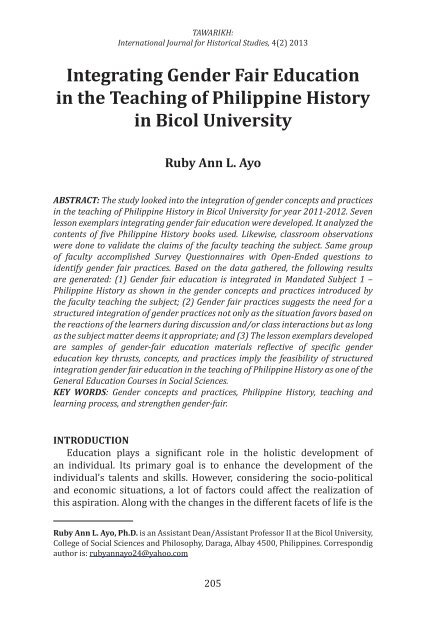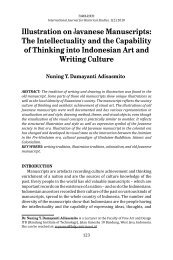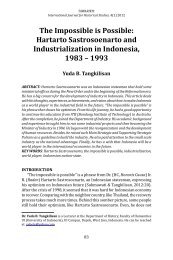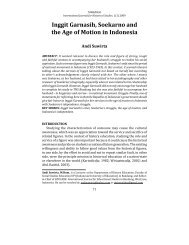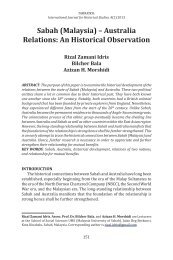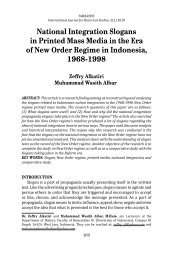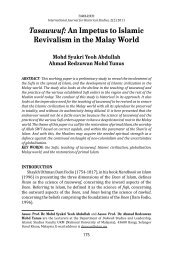Full Text in PDF - Tawarikh Journal
Full Text in PDF - Tawarikh Journal
Full Text in PDF - Tawarikh Journal
Create successful ePaper yourself
Turn your PDF publications into a flip-book with our unique Google optimized e-Paper software.
TAWARIKH:International <strong>Journal</strong> for Historical Studies, 4(2) 2013expectations set by the gendered <strong>in</strong>stitutions; hence, may result <strong>in</strong>tothe development of gender appropriate behavior (Marshall & Reihartz,1997).This is <strong>in</strong> cognizance with the explanations of the sociologists thatthe process of socialization <strong>in</strong>luences the behavior of the <strong>in</strong>dividuals.As po<strong>in</strong>ted-out by Margaret Andersen (1993), the controls exercised bythe process of socialization gives the <strong>in</strong>dividual of a de<strong>in</strong>ition on oneself.Similarly, it de<strong>in</strong>es the external world and the place <strong>in</strong> it. It even providesde<strong>in</strong>ition of others, <strong>in</strong>clud<strong>in</strong>g their relationships with oneself and thepeople they <strong>in</strong>teract with. And, lastly, may encourage and/or discouragethe acquisition of certa<strong>in</strong> skills by gender. Hav<strong>in</strong>g these considerations athand, thus, the study was undertaken.The study speciically looked <strong>in</strong>to the: (1) Identiication of genderconcepts that are <strong>in</strong>tegrated <strong>in</strong> the curriculum of Philipp<strong>in</strong>e History; (2)Identiication of gender-related practices of the teacher <strong>in</strong> the teach<strong>in</strong>gof Philipp<strong>in</strong>e History; and (3) Preparation of gender-fair curriculummaterials that can be used <strong>in</strong> the teach<strong>in</strong>g of Philipp<strong>in</strong>e History.METHODThe study made use of descriptive survey method. The descriptivesurvey method refers to “the general procedure employed <strong>in</strong> studies thathave for their chief purpose the description of phenomena <strong>in</strong> contrastto ascerta<strong>in</strong><strong>in</strong>g what caused them and what their value and signiicanceare” (Fraenkel & Wallace, 2006). The descriptive survey was used for theidentiication of the gender concepts that are <strong>in</strong>tegrated <strong>in</strong> the curriculumas well as the identiication of the gender related practices of the teachers<strong>in</strong> the teach<strong>in</strong>g of Philipp<strong>in</strong>e History.The study <strong>in</strong>volved 8 (eight) faculty members of the General EducationDepartment teach<strong>in</strong>g Philipp<strong>in</strong>e History regardless whether they are ona full time or part-time status. They were asked to accomplish the GenderConcepts Inventory Checklist which served as survey <strong>in</strong>strument. The samegroup of faculty was made to answer open-ended type of questionnaire<strong>in</strong> order to capture the gender fair education concepts and practices <strong>in</strong>their respective classes. Similarly, their classes were observed <strong>in</strong> orderto identify the gender fair practices applied. In order to validate the datagenerated from the survey questionnaire, open-ended questionnaireand observation of classes, content analysis of 5 (ive) Philipp<strong>in</strong>e Historybooks currently be<strong>in</strong>g used was likewise done.The data gather<strong>in</strong>g <strong>in</strong>struments <strong>in</strong>clude the Observation Guide, theGender Concepts Inventory Checklist, and the Open-Ended Questionnaire.207
RUBY ANN L. AYO,Integrat<strong>in</strong>g Gender Fair EducationGender ConceptsGender Audit:The term refers to the tool or<strong>in</strong>strument used <strong>in</strong> managementand plann<strong>in</strong>g. It evaluates theculture of an organization <strong>in</strong>terms of gender responsiveness aswell as the <strong>in</strong>tegration of genderperspective <strong>in</strong> the work cultureand <strong>in</strong> the entire organization;hence, the audit aims to guidethe organization to become moregender responsive.Gender Division of Labor:This is the outcome of how thesociety justly divides the workamong women and men basedon what is considered to beappropriate and suitable.Gender Equality:The term means that womenand men are provided withequal conditions <strong>in</strong> order for thehuman rights be fully realized;thus, be able to contribute aswell as beneit from economic,socio-cultural, and politicaldevelopment. The term furthersuggests recogniz<strong>in</strong>g and valu<strong>in</strong>gthe similarities and differencesbetween men and women.Gender Equity:Gender equity refers to the “fairnessof treatment for women and menaccord<strong>in</strong>g to their respective needs,<strong>in</strong>clud<strong>in</strong>g the equal treatmentconsidered equivalent <strong>in</strong> terms ofrights, beneits, obligations, andopportunities”.Gender Lens:The term refers to a set ofquestions or could also be achecklist of criteria which arerout<strong>in</strong>ely used to determ<strong>in</strong>e theparticipation, needs, and therealities affect<strong>in</strong>g women and men.Claims of the FacultyWeightedMeanAdjectivalRat<strong>in</strong>gContent Analysis of IMsWeightedMeanAdjectivalRat<strong>in</strong>g3.87 Very Good 2.05 Fair4.12 Very Good 3.80 Very Good4.00 Very Good 3.56 Good4.25 Very Good 3.61 Very Good3.50 Good 2.04 Fair210
TAWARIKH:International <strong>Journal</strong> for Historical Studies, 4(2) 2013Gender ConceptsGender Ma<strong>in</strong>stream<strong>in</strong>g:Gender ma<strong>in</strong>stream<strong>in</strong>g refers tothe approach be<strong>in</strong>g used <strong>in</strong> order to<strong>in</strong>tegrate the needs, and experiencesof women and men <strong>in</strong>to the design,implementation, monitor<strong>in</strong>g,and evaluation of policies andprogrammes <strong>in</strong> the socio-political,economic, religious, and societalaspects <strong>in</strong> order for women and mento enjoy equal beneits.Sex:The term refers to the biologicaldifferences between women andmen which is determ<strong>in</strong>ed at birth.Sex-Disaggregated Data:This refers to the quantitativestatistical <strong>in</strong>formation on thedifferences and <strong>in</strong>equalitiesbetween women and men.Strategic Interests:The term refers to the <strong>in</strong>stancesand/or situations that providemore choices, options or voice. Thechoices, options, and voices oftenties apply to the essential issuesrelated to or affect<strong>in</strong>g women.Women <strong>in</strong> Development:This refers to an approach whichaims to assimilate women <strong>in</strong> theexist<strong>in</strong>g development processspecially <strong>in</strong> activities designed topromote the welfare of the women,health even <strong>in</strong> the transformationof unequal relationships.Claims of the FacultyWeightedMeanAdjectivalRat<strong>in</strong>gContent Analysis of IMsWeightedMeanAdjectivalRat<strong>in</strong>g4.12 Very Good 2.38 Good4.12 Very Good 3.62 Very Good3.75 Very Good 1.46 Fair3.87 Very Good 1.73 Fair4.00 Very Good 3.59 Very Good4.00 Very Good 2.81 GoodAs relected <strong>in</strong> the table above, data shows that gender concepts are<strong>in</strong>tegrated <strong>in</strong> the teach<strong>in</strong>g of Mandated Subject 1 – Philipp<strong>in</strong>e History.However, the comparison of data show the discrepancies <strong>in</strong> the claims ofthe faculty teach<strong>in</strong>g Philipp<strong>in</strong>e History and the result of the analysis of thecontent of 5 (ive) Philipp<strong>in</strong>e History books as one of the IMs (InstructionalMaterials) currently used. N<strong>in</strong>e out of the fourteen gender concepts relect211
RUBY ANN L. AYO,Integrat<strong>in</strong>g Gender Fair Educationdifferences <strong>in</strong> the two sources of data. This applies to the gender conceptssuch as gender; gender analysis; gender and development; gender audit;gender lens; gender ma<strong>in</strong>stream<strong>in</strong>g; sex disaggregated data; strategic<strong>in</strong>terests; and women and development (Vega et al., 2006). The datarelect that the weighted mean based on the claims of the faculty is highercompared to the weighted mean based on the analysis of the content ofthe books be<strong>in</strong>g used.Meanwhile, the concept of empowerment; gender division of labor;gender equality; gender equity; and sex relect the same weighted meanboth from the claims made by the faculty as well as from the analysis ofcontent. This means that the claims of the faculty were validated by theanalysis of content and vice-versa (Eccles, 1986).The data shown <strong>in</strong> table 1 implies that <strong>in</strong> the teach<strong>in</strong>g of Philipp<strong>in</strong>eHistory, gender concepts are <strong>in</strong>corporated whenever appropriate. Itimplies further that with the teach<strong>in</strong>g of Philipp<strong>in</strong>e History, topics are notmerely limited to the historical facts narrated <strong>in</strong> the books but additional<strong>in</strong>formation on related topics are likewise discussed <strong>in</strong> class. It impliesfurther that there are topics <strong>in</strong>corporated <strong>in</strong> the teach<strong>in</strong>g of Philipp<strong>in</strong>eHistory which enrich the discussion of the historical events.Moreover, it implies that aside from the usual topics identiied <strong>in</strong>Philipp<strong>in</strong>e History, it also <strong>in</strong>cluded discussions on how women and menare given the freedom to be <strong>in</strong> control of their lives which <strong>in</strong> turn helpdevelop their skills and conidence, especially when it comes to solv<strong>in</strong>gproblems. This is a manifestation of the presence of gender fair education<strong>in</strong> the curriculum. This suggests that <strong>in</strong> the discussion of the Philipp<strong>in</strong>ehistorical events, the roles and responsibilities of both women whichwere decided on either by the families, societies or even as a result ofthe cultural practices are <strong>in</strong>corporated <strong>in</strong> the discussions of the identiiedtopics <strong>in</strong> Philipp<strong>in</strong>e History (Avecedo & Patricio, 2006).This implies further that aside from the discussions on the eventsthat happened dur<strong>in</strong>g the pre-Hispanic to the contemporary Philipp<strong>in</strong>eRepublics, there are also discussions on <strong>in</strong>vestigat<strong>in</strong>g the causes of gender<strong>in</strong>equality among the women and men <strong>in</strong> the Philipp<strong>in</strong>e society. Similarly,there are discussions that revolved around the <strong>in</strong>terventions <strong>in</strong>troduced<strong>in</strong> order to address the <strong>in</strong>equality <strong>in</strong> gender relations. The <strong>in</strong>equalitymay be <strong>in</strong> relation to the decision-mak<strong>in</strong>g process which means that thewomen may not be given voices. Or the <strong>in</strong>equalities may also be <strong>in</strong> termsof shar<strong>in</strong>g the beneits that each sex has to enjoy or even <strong>in</strong> uphold<strong>in</strong>g the<strong>in</strong>terests deemed equally strategic for both sexes.Other implications that can be drawn are <strong>in</strong> the teach<strong>in</strong>g of the Philipp<strong>in</strong>e212
TAWARIKH:International <strong>Journal</strong> for Historical Studies, 4(2) 2013historical events, the view of the educational theorists on maximizationof the utilization of learn<strong>in</strong>g is considered. This further implies that therewere gender concepts which were “borrowed” <strong>in</strong> order to support anotherconcept. In a way, this supports the holistic development of the learner.On the other hand, <strong>in</strong> the discussions of the topics <strong>in</strong>tended for MandatedSubject 1 – Philipp<strong>in</strong>e History, there is an emphasis on recogniz<strong>in</strong>g andvalu<strong>in</strong>g the similarities as well as differences between women and men.This may help <strong>in</strong> address<strong>in</strong>g the differences <strong>in</strong> the education receivedby boys and girls <strong>in</strong> the classroom as po<strong>in</strong>ted-out by D. Sadker and M.Sadker (1994). In the same <strong>in</strong>stance, they claimed that “Sitt<strong>in</strong>g <strong>in</strong> the sameclassroom, read<strong>in</strong>g the same textbook, listen<strong>in</strong>g to the same teacher, boysand girls receive very different educations”. Us<strong>in</strong>g this as premise, then,the <strong>in</strong>tegration of gender equality may support <strong>in</strong> the realization <strong>in</strong> theachiev<strong>in</strong>g equal conditions between sexes (Sadker & Sadker, 1994).In terms of the discussions on the “rights, beneits, obligations, andopportunities” suggests that consider<strong>in</strong>g gender equality is regardedsynonymous to human rights, <strong>in</strong> the discussion of the topics <strong>in</strong>cluded <strong>in</strong>Philipp<strong>in</strong>e History, especially on the status of women and men from the prehistoricperiod until the present equal value and equal treatment are givenemphasis. This approach supports the view presented by S. Kle<strong>in</strong> (1995),where<strong>in</strong> <strong>in</strong>tegration <strong>in</strong> the curriculum is considered as <strong>in</strong>terdiscipl<strong>in</strong>aryapproach <strong>in</strong> education.In terms of <strong>in</strong>tegration <strong>in</strong> the context of gender fair education, theAmerican Association of University Women published an important reportdeal<strong>in</strong>g with gender <strong>in</strong>equity <strong>in</strong> the classroom (Bailey, 1992). It illustratesthe biases <strong>in</strong> the educational system which may be addressed by the properimplementation of gender fair education.Based on the implications drawn from the data presented, the claim of thefaculty handl<strong>in</strong>g Mandated Subject 1 – Philipp<strong>in</strong>e History relects the <strong>in</strong>sightsof the educational theorists when they claimed that “<strong>in</strong>tegration help youngm<strong>in</strong>ds discover roots runn<strong>in</strong>g underground whereby contrary and remote th<strong>in</strong>gscohere and lower out from one stem”. This implies that <strong>in</strong>tegration enrichedthe entire teach<strong>in</strong>g-learn<strong>in</strong>g process. One of the educational theorists evenbelieved that <strong>in</strong>tegration is a revolutionary pedagogical strategy <strong>in</strong> the realmof <strong>in</strong>terdiscipl<strong>in</strong>ary approach <strong>in</strong> education.As relected <strong>in</strong> the analysis of the data gathered, it illustrates one ofthe three classiications of the models of <strong>in</strong>tegration as po<strong>in</strong>ted-out by R.Fogart (2010) which is the <strong>in</strong>tegration across several discipl<strong>in</strong>es. Philipp<strong>in</strong>eHistory is one of the numerous discipl<strong>in</strong>es of Social Sciences. And, gender is213
RUBY ANN L. AYO,Integrat<strong>in</strong>g Gender Fair Educationoften associated <strong>in</strong> the discipl<strong>in</strong>e of Sociology which like Philipp<strong>in</strong>e Historyis also one of the many discipl<strong>in</strong>es of Social Sciences. This shows thattwo discipl<strong>in</strong>es were considered <strong>in</strong> the <strong>in</strong>tegration of the various genderconcepts. This further suggests that skills and knowledge learned by thestudents <strong>in</strong> one discipl<strong>in</strong>e were re<strong>in</strong>forced and/or strengthened <strong>in</strong> anotherhence, provided the students with more afluent learn<strong>in</strong>g experiences.Meanwhile, table 2 shows the gender fair practices observed amongthe faculty teach<strong>in</strong>g Philipp<strong>in</strong>e History.Table 2:Frequency Distribution on Classroom Observation Aimed to Integrate Gender Conceptsand Practices <strong>in</strong> the Teach<strong>in</strong>g of Mandated Subject 1 – Philipp<strong>in</strong>e HistoryIndicatorsClassroom Practices:1. Promote awarenesson the sexist roles and<strong>in</strong>tegrate them <strong>in</strong> theclass discussion wheneverappropriate.2. Regularly observeand check classroommanagement practices.3. Regularly re-appraisesex-role behavior.4. Resource persons <strong>in</strong>vited<strong>in</strong> class represent genderfair behavior.5. Explore possibilitiesfor students to engage <strong>in</strong>non-traditional as wellas traditional careersas future school<strong>in</strong>g arediscussed.6. Encourage both male andfemale students to be freefrom biases perta<strong>in</strong><strong>in</strong>g tothe non-traditional beliefs.7. Refra<strong>in</strong> from us<strong>in</strong>g verbalexpressions and/or cliché srelect<strong>in</strong>g traditional viewson women.Frequency5 4 3 2 1Ex VG G F PWeightedMeanAdjectivalRat<strong>in</strong>g1 2 1 0 4 2.500 Fair0 0 4 1 3 2.125 Fair0 0 4 1 3 2.125 Fair- - - - - - -0 0 1 3 4 1.625 Fair0 2 2 3 1 2.625 Good0 2 2 1 3 2.375 Fair214
TAWARIKH:International <strong>Journal</strong> for Historical Studies, 4(2) 2013Indicators8. Call the attentionof students to any<strong>in</strong>structional materialsrelect<strong>in</strong>g unrealistic rolesof males and females aswell as relect<strong>in</strong>g unfairtreatment to females.9. Avoid the use of genderbiased terms <strong>in</strong>steadpromote the use of gendersensitive terms.Classroom Practices:1. Highlight <strong>in</strong> thediscussion of Philipp<strong>in</strong>ehistorical events thesigniicant and untypicalrole of women.2. Emphasize both thetraditional and nontraditionalroles of womenfrom the pre-Hispanicperiod until the present.3. Integrate <strong>in</strong> thediscussion the biographiesof liv<strong>in</strong>g women andmen who broke sex-rolestereotypes and comparethem to the biographiesof well-known Philipp<strong>in</strong>eheroes.4. Include <strong>in</strong> thediscussion the signiicantachievements of Filip<strong>in</strong>owomen <strong>in</strong> the country’shistory.5. Integrate <strong>in</strong> thediscussion the stereotyp<strong>in</strong>gof male and female rolesas one of the changes <strong>in</strong>the Philipp<strong>in</strong>e societybrought by the Spanishcolonization.Frequency5 4 3 2 1Ex VG G F PWeightedMeanAdjectivalRat<strong>in</strong>g0 0 0 0 8 1.000 Poor0 1 2 3 2 2.250 Fair0 3 1 0 4 2.375 Fair0 3 1 1 3 2.500 Fair0 1 3 1 3 1.875 Fair0 2 2 1 3 2.375 Fair1 2 1 1 3 2.625 Good215
RUBY ANN L. AYO,Integrat<strong>in</strong>g Gender Fair EducationIndicatorsFrequency5 4 3 2 1Ex VG G F PWeightedMeanAdjectivalRat<strong>in</strong>gOther RelevantClassroom Practices:1. Introduce the follow<strong>in</strong>gactivities as enrichment forlearn<strong>in</strong>g:1.1. Assign the studentsto write to the publisherto call the attention onpossible biases on the - - - - - - -portrayal of men andwomen roles <strong>in</strong> Philipp<strong>in</strong>esociety.1.2. Modify theterm<strong>in</strong>ologies <strong>in</strong> the<strong>in</strong>structional materials 0 0 0 0 8 1.000 Poorused so as to relect gendersensitive term<strong>in</strong>ologies.1.3. Review list of activitiesengaged <strong>in</strong> by prom<strong>in</strong>entFilip<strong>in</strong>o heroes which could 0 0 0 0 8 1.000 Poorbe relections of sex biases<strong>in</strong> Philipp<strong>in</strong>e history.1.4. Write relection papersor do similar activitieswhich aims to discuss the 0 0 3 3 2 1.750 Fairhistorical views on Filip<strong>in</strong>owomen and men.1.5. Refra<strong>in</strong> from use ofdependence themes usually 0 0 2 3 3 1.875 Fairattributed to women.Weighted Mean 2.000 FairThe most visible or dom<strong>in</strong>ant gender fair related practices are theencouragement of both female and male students to be freed from thebiases perta<strong>in</strong><strong>in</strong>g to non-traditional beliefs and the <strong>in</strong>tegration <strong>in</strong> thediscussion of the stereotyp<strong>in</strong>g of male and female roles as one of thechanges <strong>in</strong> the Philipp<strong>in</strong>e society brought by the Spanish colonization.In general, the general fair practices observed and practiced among thePhilipp<strong>in</strong>e History classes were found to be “fair” as relected by theweighted mean of 2.000.The different classroom practices may be considered as one of the216
TAWARIKH:International <strong>Journal</strong> for Historical Studies, 4(2) 2013<strong>in</strong>dicators of effective as well as eficient teach<strong>in</strong>g-learn<strong>in</strong>g process. Onecannot over rule the fact that there are expectations set by the societyas well as by the various <strong>in</strong>stitutions which <strong>in</strong>luences the beliefs andpractices of an <strong>in</strong>dividual. The school is one of the <strong>in</strong>stitutions that play acrucial role <strong>in</strong> shap<strong>in</strong>g the m<strong>in</strong>ds of the learners.One of the many examples that may illustrate the expectations with<strong>in</strong>the society is on gender. From the sociological po<strong>in</strong>t of view, genderis “systematically structured <strong>in</strong> social <strong>in</strong>stitutions, which is deeplyembedded <strong>in</strong>to the social structures” (Andersen, 1993). Gender, therefore,is created at the onset <strong>in</strong> the family, with<strong>in</strong> social relationships, amongthe schools, <strong>in</strong> the realm of religion, with<strong>in</strong> the economic structure, andeven <strong>in</strong> the state. From these, the total pattern of gender relations isde<strong>in</strong>ed. Margaret Andersen (1993) expla<strong>in</strong>ed that based on the de<strong>in</strong>edsocial patterns results the practice of stereotyp<strong>in</strong>g, the development of<strong>in</strong>terpersonal relationships, the placement of both women and men <strong>in</strong> thevarious social, economic, and political hierarchies.The school be<strong>in</strong>g the <strong>in</strong>stitution that provides the formal tra<strong>in</strong><strong>in</strong>g playsa delicate role <strong>in</strong> shap<strong>in</strong>g the m<strong>in</strong>ds of the learners, speciically alongthe de<strong>in</strong>ition of gender. As relected <strong>in</strong> the historical accounts whetherglobally or with<strong>in</strong> the Philipp<strong>in</strong>es, it is recorded that educational systemused to portray an authoritarian nature. The teachers themselves admittedthat, <strong>in</strong> practice, they imposed different standards of discipl<strong>in</strong>es betweenboys and girls. At one po<strong>in</strong>t <strong>in</strong> history, there was even the existence of sexsegregatedschools as represented by the existence of exclusive schools forboys and exclusive schools for girls. This illustrates that schools and eventeachers channel boys and girls towards the suppose gender appropriatebehavior and activities.In the illustration of the learn<strong>in</strong>g situations from the teachers’ po<strong>in</strong>tof view of R.F. Garcia (2012), he stressed the role plays by the teachers<strong>in</strong> stimulat<strong>in</strong>g the m<strong>in</strong>ds of the students <strong>in</strong> any learn<strong>in</strong>g situations.He expounded on the idea that as the child attends school, the level of<strong>in</strong>teraction between the child and the teacher is greater than compared tothe child’s exposure to the parents; hence, the teacher plays a salient andsensitive role <strong>in</strong> child development.The data as shown <strong>in</strong> table 3 relect that among the practices <strong>in</strong> theclassrooms two got an adjectival rat<strong>in</strong>g of “good”. These are the classroompractice of encourag<strong>in</strong>g the students to be freed from biases, speciicallyon the non-traditional beliefs and the <strong>in</strong>clusion of stereotyp<strong>in</strong>g <strong>in</strong> thediscussion of the Philipp<strong>in</strong>e historical events as relected as one ofthe changes <strong>in</strong> the society brought by the Spanish colonization. This217
RUBY ANN L. AYO,Integrat<strong>in</strong>g Gender Fair Educationimplies that these were frequently observed as the situation deemed itappropriate. This implies further that the faculty handl<strong>in</strong>g the MandatedSubject 1 classes considered the appropriateness of the topics as well asthe practices where gender practices could be <strong>in</strong>culcated.On the other hand, most of the practices and the discussions wereobserved to be fair. This means that they were occasionally observed as thesituation deemed them appropriate. This means further that even thoughthere were topics or situations <strong>in</strong> the class which may appropriately<strong>in</strong>tegrate gender fair practices yet, the observance was rarely done. The<strong>in</strong>frequent observance may be attributed to several factors. Some of thefactors which could have <strong>in</strong>luenced the occasional observance of genderfair practices are the rout<strong>in</strong>e practice done <strong>in</strong> the classrooms and theconformance to the <strong>in</strong>stitutional de<strong>in</strong>itions of gender (Jacobs, 1990).Meanwhile, the rest of the practices and discussions observed werepoor. This implies that even though there were topics, situations andpractices which may appropriately capture the discussions and <strong>in</strong>troductionof gender fair practices <strong>in</strong> the classroom these were not captured. Theopportunities were either deliberately or <strong>in</strong> deliberately ignored for genderfair education to be promoted (Avecedo & Patricio, 2005).As captured by the responses of the faculty based on their responses<strong>in</strong> the Open-Ended Questionnaire, it shows that the exist<strong>in</strong>g <strong>in</strong>structionalmaterials be<strong>in</strong>g used vary from the teacher made IMs (InstructionalMaterials) to the readily made/bought such as books, globes, maps, andthe like. The data also shows that with regard to the preparation of theteacher-made IMs not all of the faculty are aware on the process be<strong>in</strong>gundertaken, especially <strong>in</strong> terms of validation. One of them talked aboutthe existence of the Instructional Materials Committee <strong>in</strong>-charged of thevalidation, however, majority is unaware of such.In terms of <strong>in</strong>tegration of gender concepts and gender fair practiceswhich are <strong>in</strong>tegrated <strong>in</strong> the IMs, majority claimed that there are onlyone asserted that seldom those concepts or topics are seen. Themajority re<strong>in</strong>forces the claim made among the responses <strong>in</strong> the surveyquestionnaire. The same holds true when asked on the gender fairsensitive practices <strong>in</strong> the classrooms.The data similarly relect the clamor for <strong>in</strong>tegration although therewere reservations that only as long as the topics deemed appropriate. Thisclamor is consistent to the pr<strong>in</strong>ciple of <strong>in</strong>tegration that the connectionsbetween two discipl<strong>in</strong>es will be done naturally and will appear seamless.Based on the identiied gender fair concepts <strong>in</strong>tegrated and gender fairpractices observed, 7 (seven) lesson exemplars were developed designed218
TAWARIKH:International <strong>Journal</strong> for Historical Studies, 4(2) 2013to structurally <strong>in</strong>tegrate gender fair education <strong>in</strong> the teach<strong>in</strong>g of Philipp<strong>in</strong>eHistory. The lesson exemplars are relective of gender education key thrustsuch as equality between sexes, sex roles and stereotyp<strong>in</strong>g, elim<strong>in</strong>ation ofgender biases, elim<strong>in</strong>ation of all forms of violence aga<strong>in</strong>st women, respectfor abilities and rights of both sexes, opposition to sexism and equalopportunities between male and female. The gender education key thrustsare supported by gender concepts which are speciically matched amongthe Philipp<strong>in</strong>e Historical periods and speciically identiied topics.Table 3:Matrix that Outl<strong>in</strong>es the Topics and Speciic Gender Concepts Integrated <strong>in</strong> the Teach<strong>in</strong>gof Mandated Subject 1 – Philipp<strong>in</strong>e HistoryTopicThe Women <strong>in</strong> theEgalitarian SocietyThe Domesticationof WomenThe Status ofWomenThe Filip<strong>in</strong>o WomenUnder the JapaneseRuleChang<strong>in</strong>g Roles ofWomen <strong>in</strong> the PostWar RepublicThe Philipp<strong>in</strong>esUnder the Rule ofWomen PresidentsThe ChallengesConfront<strong>in</strong>g Women<strong>in</strong> the ContemporaryTimePhilipp<strong>in</strong>eHistoricalPeriodPre-HistoricSpanishAmericanJapanesePeriod ofPhilipp<strong>in</strong>eRepublics-do--do-Gender EducationKey ThrustEquality betweensexesSex roles andstereotyp<strong>in</strong>gElim<strong>in</strong>ation ofgender biasesElim<strong>in</strong>ation of allforms of violenceaga<strong>in</strong>st womenRespect for abilitiesand rights of bothsexesEqual opportunitiesbetween males andfemalesRespect for abilitiesand rights of bothsexesGender Concepts▪ Empowerment▪ Gender▪ Gender Equality▪ Gender Equity▪ Gender Division of Labor▪ Gender Analysis▪ Gender and Development▪ Sex-Disaggregated Data▪ Empowerment▪ Gender▪ Gender Equality▪ Gender Equity▪ Gender Ma<strong>in</strong>stream<strong>in</strong>g▪ Empowerment▪ Gender▪ Gender Equality▪ Gender Equity▪ Women <strong>in</strong> Development▪ Empowerment▪ Gender▪ Gender Equality▪ Gender Equity▪ Women <strong>in</strong> Development▪ Gender Lens219
RUBY ANN L. AYO,Integrat<strong>in</strong>g Gender Fair EducationThe seven lesson exemplars were designed cover<strong>in</strong>g ive majorhistorical periods <strong>in</strong> Philipp<strong>in</strong>e History. The proposed lesson exemplarsfollowed the template us<strong>in</strong>g the 4E’s approach. The essential parts <strong>in</strong>cludethe Title, Year Level or Placement; Benchmarks; Objectives; ConceptsTaught; Gender Concepts Integrated; Materials; Procedures; and Evaluate.The procedure has the follow<strong>in</strong>g sub-parts: Engage, Explore, Expla<strong>in</strong> andElaborate.Meanwhile, the Philipp<strong>in</strong>e historical events captured were the prehistoric,Spanish period, American period, Japanese period, and the periodof the Philipp<strong>in</strong>e Republics. One lesson exemplar from each period fromthe pre-historic to the Japanese periods were developed whereas, threelesson exemplars from the period of Philipp<strong>in</strong>e Republics were designed.Based on the table, it captures the speciic topics <strong>in</strong> Philipp<strong>in</strong>e historywhere gender concepts could be aptly <strong>in</strong>tegrated along with the genderkey thrusts and the de<strong>in</strong>ite gender concepts <strong>in</strong>tegrated.CONCLUSIONGender fair education is <strong>in</strong>tegrated <strong>in</strong> Mandated Subject 1 – Philipp<strong>in</strong>eHistory as shown <strong>in</strong> the gender concepts and practices <strong>in</strong>troduced by thefaculty teach<strong>in</strong>g the subject. This manifests the awareness of the facultyon certa<strong>in</strong> gender concepts and practices and their relevance on speciictopics <strong>in</strong> Philipp<strong>in</strong>e History. However, the <strong>in</strong>d<strong>in</strong>gs further revealed theneed to expand the number of gender concepts which may possibly be<strong>in</strong>tegrated <strong>in</strong> the teach<strong>in</strong>g of Philipp<strong>in</strong>e History.On the other hand, the <strong>in</strong>d<strong>in</strong>gs on gender fair practices imply the needfor a structured <strong>in</strong>tegration of gender practices not only as the situationfavors based on the reactions of the learners dur<strong>in</strong>g discussion and/orclass <strong>in</strong>teractions but as long as the subject matter deems it appropriate.The lesson exemplars developed are samples of gender-fair educationmaterials relective of speciic gender education key thrusts, concepts, andpractices. This implies the feasibility of structured <strong>in</strong>tegration gender faireducation <strong>in</strong> the teach<strong>in</strong>g of Philipp<strong>in</strong>e History as one of the GEC (GeneralEducation Courses) <strong>in</strong> Social Sciences.Based on the <strong>in</strong>d<strong>in</strong>gs of the study, the follow<strong>in</strong>g recommendationsare forwarded: (1) to conduct a follow-up study which may check on thediscrepancies on the claims made by the faculty handl<strong>in</strong>g the subjects withthe <strong>in</strong>ventory made on the books be<strong>in</strong>g used as part of the <strong>in</strong>structionalmaterials; (2) to encourage the faculty handl<strong>in</strong>g Philipp<strong>in</strong>e History classesto strengthen gender-fair practices <strong>in</strong> the classroom through tra<strong>in</strong><strong>in</strong>gs,exposure to read<strong>in</strong>g materials or other audio-visual materials which may220
TAWARIKH:International <strong>Journal</strong> for Historical Studies, 4(2) 2013<strong>in</strong>luence them and eventually adopt said practices <strong>in</strong> the classrooms; (3)to try-out the seven lesson exemplars prepared as a form of validation;and (4) to conduct parallel researches with other General EducationCourses <strong>in</strong> Social Sciences as a focus.ReferencesAguilar, Carmencita. (1997). Gender Education <strong>in</strong> the Curriculum. Manila: PNU [Philipp<strong>in</strong>eNormal University] Press.Andersen, Margaret. (1993). Th<strong>in</strong>k<strong>in</strong>g about Women: Sociological Perspectives on Sex andGender. New York: Macmillan Publish<strong>in</strong>g Company.Avecedo, Patricia & Joanne Patricio. (2005). “Compilation of Read<strong>in</strong>gs and Handouts forTra<strong>in</strong><strong>in</strong>g and Workshop on Gender Fair Education” <strong>in</strong> Nursia. Philipp<strong>in</strong>es: Institute ofWomen’s Studies, 24-28 October.Avecedo, Patricia & Joanne Patricio. (2006). “Beyond P<strong>in</strong>k and Blue” <strong>in</strong> Smart Parent<strong>in</strong>g,October Issue.Bailey, S. (1992). How Schools Shortchange Girls: The AAUW Report. New York: Marlowe &Company.Castro & Galace. (2008). A Pathway to a Culture of Peace. Quezon City, Philipp<strong>in</strong>es: Centerfor Peace, Miriam College.Dela Cerna, Soia. (1986). Integrat<strong>in</strong>g Gender Perspective <strong>in</strong> the Curriculum. Manila: PNU[Philipp<strong>in</strong>e Normal University] Press.Eccles, J.S. (1986). “Gender Roles and Women’s Achievement” <strong>in</strong> Educational Researcher,June-July edition.Fogart, R. (2010). “Ten Ways to Integrate Curriculum” <strong>in</strong> Educational Leadership, 449(2),pp.61-65.Fraenkel & Wallace. (2006). How to Design and Evaluate Research <strong>in</strong> Education. New York:McGraw Hill.Garcia, R.F. (2012). “Overview of Learn<strong>in</strong>g Situations <strong>in</strong> the Philipp<strong>in</strong>es”. Handouts. Daraga,Albay, Philipp<strong>in</strong>es: College of Social Sciences and Philosophy BU [Bicol University].Jacobs, J.A. (1990). “Gender and Academic Specialties: Trends among Recipients of CollegeDegrees <strong>in</strong> the 1980s” <strong>in</strong> Sociology of Education.Kle<strong>in</strong>, S. (1995). Handbook for Achiev<strong>in</strong>g Sex Equity Through Education. Baltimore, MD: TheJohns Hopk<strong>in</strong>s University Press.Marshall, C.S. & J. Reihartz. (1997). “Gender Issues <strong>in</strong> the Classroom” <strong>in</strong> Clear<strong>in</strong>ghouse,70(6), pp.333-338.Sadker, D. & M. Sadker. (1994). Fail<strong>in</strong>g at Fairness: How Our Schools Cheat Girls. Toronto:Simon & Schuster Inc.Vega, Violeta et al. (2006). Social Diemensions of Education. Quezon City: Lorimar.221
RUBY ANN L. AYO,Integrat<strong>in</strong>g Gender Fair EducationUndergraduate Students of Bicol University(Source: www.google.com, 24/3/2013)Gender fair education is <strong>in</strong>tegrated <strong>in</strong> Mandated Subject 1 – Philipp<strong>in</strong>e History as shown<strong>in</strong> the gender concepts and practices <strong>in</strong>troduced by the faculty teach<strong>in</strong>g the subject. Thismanifests the awareness of the faculty on certa<strong>in</strong> gender concepts and practices andtheir relevance on speciic topics <strong>in</strong> Philipp<strong>in</strong>e History.222


